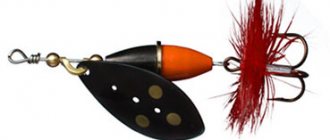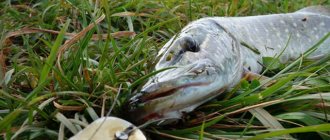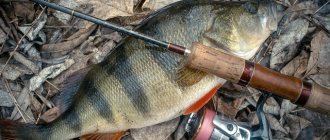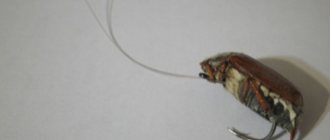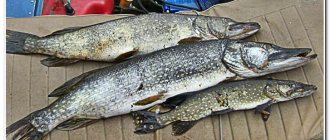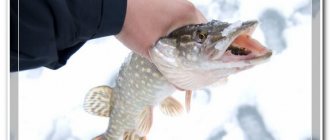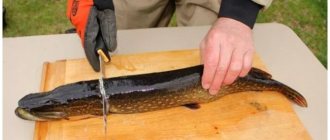Pike is a fish that any angler will not refuse. Nowadays, the method of catching pike using the artificial bait duck, which is classified as a wobbler, is rapidly gaining popularity. However, duckling fishing has a number of features that you need to familiarize yourself with before fishing.
Features of the duckling bait
The duck lure for pike appeared on the fishing market relatively recently, but many anglers have already fallen in love with it. In appearance, the bait is almost indistinguishable from a real duckling, but some anglers say that the shape of the bait is copied from a frog-shaped bait.
Duckling bait for pike is available in different sizes. Its weight can vary from 30 to 40 grams, and its length can vary from 10 to 15 centimeters. The peculiarity of the bait is that such a bait can be equipped with either two or three hooks. The coloring of the duckling is completely copied from a real duck.
Experienced fishermen advise fishing for ducklings in the spring, when real ducklings, along with ducks, go into the water. Despite this, some anglers actively fish for pike in the spring.
Places for catching pike with duck bait
As for the choice of a place for catching pike with duckling bait, it is worth saying that the most effective places will be those places in the reservoir where real ducks are found. Thus, fishing will be most productive in backwaters, dams, areas of lakes and reservoirs near the coastline.
If fishing is carried out on a river, then the most effective places will be whirlpools and points of the reservoir below the level of locks and dams. Most often, the pike is located next to the main stream, hiding behind a stone, snag or other object - so you need to cast the duck at the extreme edge of the stream. It is also worth paying attention to the fact that in rivers you most often find trophy-sized pike, so you need to equip your fishing rod accordingly.
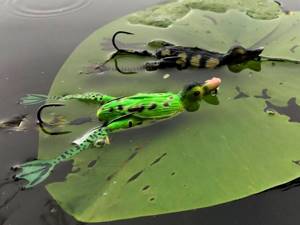
It is recommended to go fishing with this bait during the daytime. The point is that the angler will need to constantly monitor the duck bait so that it moves like a real duck. At night, it is almost impossible to carry out correct wiring with the nozzle. During the feeding season, you can catch pike with ducklings throughout the daylight hours. In summer, the peak pike bite occurs in the early morning and late evening. In autumn you can go fishing during the day.
Rod for catching pike with duck bait
When catching pike with duck bait, it is better to abandon ultralight spinning rods. The fact is that such a bait most often catches large pikes, and an ultralight rod may simply not be able to withstand the weight of a large specimen. The optimal choice would be a rod with a test load of 30 to 80 grams. As for the length of the tackle, a three-meter spinning rod is good for fishing from the shore, and a two-meter rod will be enough for fishing from a boat.
Experienced fishermen recommend giving preference to spinning rods made of composite material. They are lightweight, but at the same time they can withstand even the largest pike. Inertia-free models perform well as reels, capable of holding up to 150 meters of fishing line. The reel can be equipped with either monofilament or braided line.
Which spinning rod to choose?
It is not recommended to use ultralight spinning rods for pike hunting. This is due to the fact that the predator can be strong, large, with powerful jaws. Often pikes actively resist during fishing, which is why ultralight models simply cannot withstand such a load.
You should also pay attention to the length of the spinning rod.
- If you prefer to fish from the shore, then a rod about 3 meters long will do.
- For fishing on a boat, the length of the spinning rod should not be more than 2.5 meters. This will be quite enough.
- Important! The strongest rods are considered to be those made from composite materials, as they are light, reliable, and strong enough, which is ideal for pike fishing.
Regarding reels, I can say from personal experience that inertia-free models that hold about 150 meters of line are best suited. You can use monofilament for the base.
TAGS:
Technique for catching pike with duck bait
As is typical for a real duck, the duckling lure has two legs on the sides that rotate during the retrieve. Thanks to this, the pike thinks that a wounded or stray duckling is swimming past it. In some magazines, this bait is even called a “pike killer”, since not a single pike can resist the temptation to feast on a small duckling.
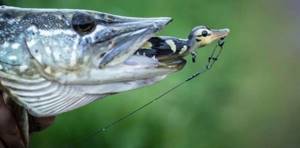
You can increase your chances of catching pike with duckling bait by using a decoy that allows you to make sounds identical to the sounds of ducklings. However, before using this tool, you should study the behavior of real ducks. It is better to throw bait into the water near snags, bushes, reeds or other aquatic vegetation. During the retrieving process, you need to periodically twitch the rod, due to which the duckling will go a little deeper into the water - this will imitate a real bird while searching for food.
Fishing technique
During retrieval, the duckling bait moves its legs like a real bird. The pike reacts accordingly to such movements and does not let the bait pass by. The predator is just waiting to swallow the little “duckling”. To achieve the best results from fishing, it is worth using a decoy that makes “duck” sounds.
- Important! It is optimal to cast using this bait model where there are reeds or other aquatic vegetation.
Wiring should be accompanied by periodic twitching of the rod. With this technique, the nozzle will sink slightly into the water, creating a realistic effect.
I want to say that I myself am a devoted fan of fishing. And if I plan to sit with a fishing rod and hunt for pike, then I go to the Sazanya Bay fishing base. Comfortable conditions for good fishing have been created there. I never return without a trophy.
TAGS:
DIY duckling bait
The easiest way to buy duckling bait is on aliexpress. The bait purchased there will be much cheaper than the foreign version, but of similar quality. Some fishermen who do not want to wait for the bait to come into their hands decide to make a duckling with their own hands.
In order to make duckling bait you need to prepare:
- plastic spoons;
- sawdust;
- stainless steel wire;
- doubles or tees (hooks);
- a piece of rubber;
- lead;
- varnish (suitable for nails);
- matches and threads;
- knife;
- glue;
- drill.
First you need to create the body of the future bait. To do this, take 4 plastic spoons and cut off their handles, then smooth out the rough edges with a hacksaw. Next, the round parts of the spoons are glued together so that they form a ball - this is the body of the bait. Two more parts of the spoon are glued to the sides of the body - wings.
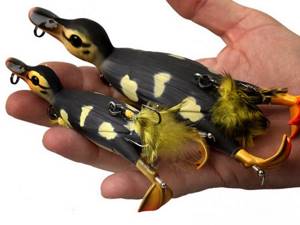
To make duckling legs, you need to take small elastic bands and attach them to the body using thin wire or thread. Hooks are hidden inside the legs - this is also done using stainless wire.
To give the structure stability, a wire frame is placed inside the nozzle. The most common option is a frame in the shape of the letter P. Sinkers are also placed on the frame, which will add weight to the duckling. They can be ordinary bolts and nuts. After the frame has been placed in the duckling's body, the remaining space must be filled with sawdust and thoroughly soaked with glue.
The head is made from the same spoons, or rather their two halves. The head is also covered with sawdust and soaked in glue. It can be attached to the body using glue or wire, however, the second option is more reliable. The last final step is to color the finished bait. To do this, just open a photo of a real duckling on the Internet and paint the nozzle in the desired colors.
Duckling on a trophy made of plastic spoons and sawdust
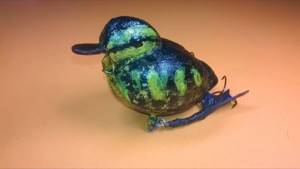
Hello fishermen, the predator hunting season has begun! This means that we will need catching gear. Of course, today the market offers a wide range of different fishing accessories, but they all cost money, and sometimes a lot. This is especially true for such baits as various wobblers and other baits that imitate some kind of animal or bird that a predator hunts. If you want to save money and make a unique and interesting bait, this instruction is just for you!
In this article we will look at how to make a decoy that imitates a duckling. Such prey is almost always attacked only by a large predator, it can be a trophy pike, asp, chub or even catfish. Making a homemade duckling is very simple, and all this is done practically from waste material, and the quality of the product is not much different from the purchased one. As a basis for production, the author used plastic spoons, which cost a penny and can also be obtained for free. And also this is a free material like sawdust, they serve as a filler. If you wish, you can cover the bait with real feathers and then it will look almost exactly like a real duckling.
So, let's take a closer look at how to make such a bait!
Materials and tools that were used by the author:
List of materials:
— disposable plastic spoons; - sawdust; - suprelkey; — stainless wire 0.8 mm thick; — two tees; — rubber from a bicycle inner tube for making paws; - lead for loading; — nail polish (for coloring); - matches; - threads.
List of tools:
- round nose pliers; - pliers; - stationery knife; - sandpaper; - file; - drill; - hacksaw blade.
Duck making process:
Step one. Making the base
To make the base, we first prepare the materials. Here you will need disposable plastic spoons. We cut off the handles from them and grind off the excess with a file. Next, we glue these parts together like the author in the photo, it may take you 3-4 spoons to make the “belly” of the duckling, and then we attach more parts to this part on the side. The author used superglue as glue; subsequently, the structure is further strengthened with matches and glue. That's all, in this simple way we made the lower part of the duckling, which a predator will see from the depths.
The duckling's feet are very important, this is one of the elements that is visible from the depths and that a predator identifies. To make paws you will need rubber from a bicycle inner tube. First, draw the foot on a piece of paper, and then cut out the template. Well, now, using this template, all that remains is to cut out two paws from rubber.
Step three. Installation of the “skeleton” inside the duckling
Inside the duckling you need to make a strong frame, it is needed so that you can install the legs with hooks. Here we will again need stainless wire. The first part we will make should look like the letter “P”. We drill holes for this part and install it. Among other things, the author strengthens the base of the duckling with matches and glue. We just drill holes, place matches on the glue and cut off the excess.
The second fastener resembles the letter “A”; as a result, when connecting both parts, you should get something like a triangle. We form loops at the ends of the structure and disguise them with black thread and glue. We attach our legs with hooks to these loops.
Step four. Loading
For such a bait, the weight is extremely important so that the duckling immediately takes the desired position when it hits the water. We install the weight from the inside on the abdomen. He must sink the duckling a little so that she swims as intended. Please note that there will still be sawdust inside, which also has weight. We attach the weight using superglue. Nuts, bolts or the like can be used as a sinker.
Step five. Tail and sides
The tail and side parts are made in the same way - from spoons. We cut them and glue them together. Next, we pour sawdust inside the duckling and soak it with glue; the entire inside of it should be filled with sawdust so that water does not enter there. Soak the sawdust well with glue, you can use PVA glue. Otherwise, the sawdust will absorb moisture and the duckling may begin to drown or swim crookedly.
We make the head from two pieces of a spoon, fill the parts with sawdust and soak them with glue. Well, then we glue both parts to each other. The author makes a beak for a duckling in a similar way. To securely attach the beak, use wires.
The head also needs to be secured securely, as it is quite massive. We drill a hole in it, as well as another hole in the body. We use a metal rod on which we attach the head. Next, there will be gaps between the head and body. You need to push pieces of shavings into these gaps and soak them with superglue. When this whole thing dries, the head will be securely fixed. All cracks must be carefully sealed with sawdust and glue; you can use small sawdust mixed with glue, you will get something like putty. Well, then we leave the whole thing to dry well.
Step seven. Coloring the duckling
The author paints the duckling using nail polish. You can use spray cans, markers, and so on. To prevent the paint from wearing off for a long time, it would be good to dip the duckling in varnish. In addition, the varnish well insulates the product from water. The author uses yellow as the main color, because most ducklings and other birds look like that. You can also make splashes of black or brown. Be sure to draw a duck's eye.
If desired, you can install a “steering wheel” in the front part like a wobbler, as a result, our duckling will “vibrate” on the water, and the predator will react to these vibrations even more readily! And if you cover the tackle with real feathers, then not even every person will be able to distinguish it from the real thing at a distance.
That's all, the project is finished, I hope you liked it. Good luck and creative inspiration if you want to repeat a similar product. Whoever succeeds, post a video of how the tackle behaves on the water and whether you managed to catch anything with it. Good luck!
Source
Become the author of the site, publish your own articles, descriptions of homemade products and pay for the text. Read more here.

